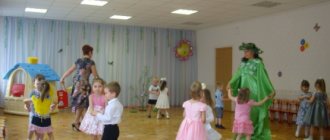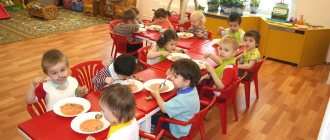Memo for teachers “Organizing the morning reception of children in kindergarten” article
Organization and holding of the morning reception
A thoughtful and well-organized morning reception for children is of great importance in the daily routine. Morning reception in kindergarten largely depends on how adults and children greeted the child. The teacher’s friendly intonation and good mood are conveyed to the children: “Hello, we are glad to see you. Goodbye, we are waiting for you again tomorrow. We will be glad to see you." If the child was greeted with kind words and kindness, then the child will have a good mood for his further stay in kindergarten.
During the morning reception, problems in all educational areas are solved.
The main task of teaching work in the morning is to include children in the general routine of kindergarten life.
Morning reception is reflected in the teachers’ calendar plan and corresponds to the calendar and thematic planning of the “Preschool Educational Program”.
You can welcome children both outdoors and indoors. In the summer, the teacher conducts morning receptions in the fresh air.
Reception of children usually starts from 7-30 o'clock and lasts until 8 - 20 o'clock. To prepare for receiving children, the teacher must come to the kindergarten in advance and ventilate the room. Prepare material for children’s joint and independent activities with the teacher - didactic games, paintings, various attributes for role-playing and outdoor games, visual aids, musical compositions, etc. The teacher prepares games and toys, arranging them in such a way that it is convenient for children to take them and play without interfering with each other.
The first thing the teacher should pay attention to during the morning reception is the state of the child’s health. If the teacher is attentive and knows well the individual characteristics of children, he can determine by appearance whether the child is healthy. As a rule, healthy children, when they come to kindergarten, begin to play, willingly communicate with each other, and move a lot. If the teacher suspects that the child is not healthy, he talks with the parents, finds out how the baby slept, whether he complained about anything, and takes his temperature. If a child’s illness is discovered after the parents leave, the teacher isolates him from other children, puts him to bed, informs family members about the incident and invites a medical professional.
A child who has not attended kindergarten for a long time should not be admitted without being examined by a doctor or nurse. If a child has missed kindergarten for more than five days, parents must provide a certificate stating that the child is healthy.
When meeting each child, the teacher talks with him about the weather outside, about the mood with which the preschooler came to kindergarten. You can ask older children: “What amazing thing did you see on the way to kindergarten, who did you meet?” In younger groups, the minute of entry is more theatrical. The child can be greeted by a fairy-tale character along with the teacher. The teacher uses songs, nursery rhymes, and bright toys that help to find contact and extinguish negative emotions. The rhythmic text of poems, nursery rhymes, and jokes encourages children to move, creating a joyful mood.
In the morning, if children come gradually, it is convenient to carry out individual work, which is planned in advance with a specific child or with a small group of children. Conversations may be accompanied by viewing illustrations accessible to children.
In the morning, the most favorable time for organizing heuristic conversations, in which cognitive tasks are solved using reasoning. The teacher must guide the course of reasoning, directing the children’s thoughts in the right direction. For example, discuss why it was slippery to go to kindergarten, remembering the warming in the evening and the morning frost, which is why an icy crust appears.
Also, in the morning, observations of indoor plants in a corner of nature are planned, work is carried out with the nature calendar (children mark the day of the week, day, month, precipitation).
Children work in the morning hours. Daily work (duties) are not planned for every day. However, if a new type of duty is introduced, the duties of the duty officers become more complicated, or conditions change, then it becomes necessary to reflect this in the plan. The teacher organizes work in a corner of nature. Children water the plants, loosen the soil, while the children fix the names of indoor plants, step by step following the rules for caring for them.
In solving problems in the “Artistic Creativity” area, children are asked to make sketches of their mood, draw music or a drawing on a free topic. You can suggest working with plasticine or clay.
The emotional comfort in the group during the day depends on how the morning reception went, how the child entered the group, and how he was greeted. The organization of the morning reception will determine in the future whether the child will be happy to go to kindergarten, willing to join the group, or will look for a reason to stay at home.
Consultation “Organization of morning reception of children at preschool educational institutions”
A thoughtful and well-organized morning reception for children is of great importance in the daily routine.
You can welcome children both outdoors and indoors. It is preferable to receive children at any time of the year in good weather in the fresh air. Of course, there may be exceptions to this. For example, if a teacher starts working with a new group of children and does not yet know them very well, or accepts a group of children who at first find it difficult to part with their loved ones, in such cases it is more advisable to organize their reception in a room where it is easier to distract children’s attention.
Morning appointments in kindergarten should begin with a preventive examination of their pupils. Knowing well the individual characteristics of the children in your group, you can determine by appearance whether the child is healthy. As a rule, healthy children, when they come to kindergarten, begin to play, willingly communicate with each other and with the teacher, and move a lot. Every morning it is necessary to have conversations with parents about how the child slept and what mood he woke up in. It also happens that you come to kindergarten already with whims, then it is advisable to find out the reason for the bad mood. If there is a suspicion that the child is not healthy, then the temperature must be measured in front of the parents. If the disease is discovered after the parents leave, the teacher isolates him from other children, puts him to bed, informs family members about the incident and invites a medical worker, if available.
In nursery groups, admission takes place with daily measurement of body temperature. During an influenza epidemic, body temperature is measured in all age groups daily. Children identified during examination with suspected illness are not admitted to kindergarten.
Morning reception in kindergarten largely depends on how the adults greeted the child, whether he was welcome, and how he was taken home in the evening. Educators should greet children and parents with a smile, a good mood, and kind, affectionate words, no matter what age group they are currently working with. After all, the friendly intonation and good mood of the teacher or assistant teacher is conveyed to the children: “Hello, we are glad to see you. Goodbye, we are waiting for you again tomorrow. We will be glad to see you." “Good morning, Tyoma, let’s go see what’s on the shelf waiting for you.”
If the child was greeted with kind words and kindness, then he will have a good mood for his further stay in kindergarten.
In a nursery group, where completely new, small children come, the teacher needs to try to be affectionate, kind, loving, warm, caress, calm, and distract. During the adaptation period, the child misses home, is unable to communicate with other children, and is depressed. Songs, nursery rhymes, bright toys help to find contact and extinguish negative emotions. Reading a nursery rhyme encourages children to take action. The rhythmic text of poems, nursery rhymes, and jokes encourages children to move, creating a joyful mood. If a child is naughty, you need to distract him, find a way to help the child relax, stroke him, set him up for good, and not rush him or shout.
You can ask older children: “What amazing thing did you see on the way to kindergarten, who did you meet?”
, or take the same note, repeat his actions, the child needs to see himself, as in a mirror.
To establish emotional contact, a pre-prepared environment for receiving children is of great importance. The organization of a developing subject-spatial environment involves the creation of conditions to protect the nervous system of children from excessive excitement. It is necessary to organize the environment accordingly, selecting benefits (music, quiet play, fairy tales with good characters, encouragement, surprises - toys - bright musical, mechanical, etc.) When the children are all gathered in a group, you can say: “Good morning, kids. A new day has come, we smile at each other. We'll have fun today, okay. Look at each other, smile. Let's wish each other a good day.
The emotional comfort in the group during the day depends on how the morning reception went, how the child entered the group, how he was greeted, whether he was expected, what mood the adults around him were in, and whether the child will be happy to go to kindergarten in the future. with a desire to join a group, or will look for a reason to stay at home.
A friendly meeting of children by the teacher affects their mood, performance, and discipline. If children know that they are expected to be welcome, they are more willing to go to kindergarten. An observant teacher sees in what mood the child came to kindergarten and shows pedagogical tact: either he immediately involves the child in activities, or gives him the opportunity to be alone and calm down.
A child entering kindergarten for the first time requires special attention. Therefore, we need to keep him occupied with a toy, distract him from sad thoughts, and I try to make the transition from home to kindergarten less painful.
Reluctance to go to kindergarten sometimes manifests itself in those children who have been attending preschool for a long time. The reasons may lie in the child’s health, overwork, failure of adults to fulfill promises, etc. Sometimes parents, rushing to work, begin to undress the child, causing his protest, or, on the contrary, spend a long time persuading him. You need to talk to such parents, convince them that all this has a negative effect on the child, affects his mood, and that after his loved ones leave, he cannot calm down for a long time.
To quickly distract a child, you need to switch his attention to something interesting. This can be done in different ways: give a small assignment, watch something interesting together, offer board games, didactic games.
When receiving children, the teacher must pay attention to their appearance. Having noticed problems, offer the child to put himself in order and help him. Teach children to use a mirror, check their appearance, correct flaws in their suit and hairstyle, developing the habit of always being clean and tidy.
From the younger group, teach children to say hello to everyone who meets them, make sure that they are polite and friendly in their interactions with each other. Some teachers make the mistake of telling children “when you come to kindergarten you need to say hello”
. You should say hello to everyone you meet, not only in kindergarten.
A child who has not attended kindergarten for a long time should not be admitted without being examined by a doctor or nurse. If a child has missed kindergarten for more than three days, parents must provide a certificate stating that the child is healthy.
If the reception takes place at the site, then upon entering the room the teacher should draw the children’s attention to ensure that they carefully wipe their shoes so as not to carry garbage from the street into the room. In the reception room, teach children to undress themselves, carefully put their clothes in their locker and change their shoes.
Think in advance about how to organize children’s activities and keep them busy with useful activities during the period from reception to preparation for breakfast. At this time, children mostly play. Therefore, it is necessary to prepare games and toys, placing them in such a way that it is convenient for children to take them and play without interfering with each other. Encourage games that arise on the initiative of the children themselves, help implement their plans, creating the necessary conditions for this. Offer children a variety of didactic games that are already familiar to them, as well as outdoor ones, which are played both on the site and indoors.
Children's work activities can be organized in the morning hours. You can involve them in caring for plants (watering flowers, loosening the soil, etc., putting toys back in place, changing dolls, etc.) Children carry out work assignments under the supervision of a teacher and with his help.
At an older age, children are on duty in a corner of nature. This time can also be spent with children (with the whole group and individually)
various observations on the site and indoors: the work of adults, natural phenomena, etc.
By involving children in various activities, the teacher forms in them the habit of being busy. Having finished receiving children, the teacher checks the work of those on duty in the nature corner and invites children to morning exercises, which are carried out in all groups, if the weather in the area allows (depending on the time of year)
. If the weather does not allow, then in a well-ventilated room (in a group, gym or music hall).
After the gymnastics, preparations for breakfast begin. The attendants set the tables, the rest of the children play sedentary games.
Thus, the morning reception of children is of great importance in organizing the whole day. Each teacher has the opportunity to keep all children occupied and interested, communicate with parents, and determine the condition and mood of the students. The plan must specifically define the activity that will be carried out, indicating the name and purpose of the activity. When organizing a morning reception, activities such as self-service and basic household work, play activities (errands, conversation, didactic games) are planned.





